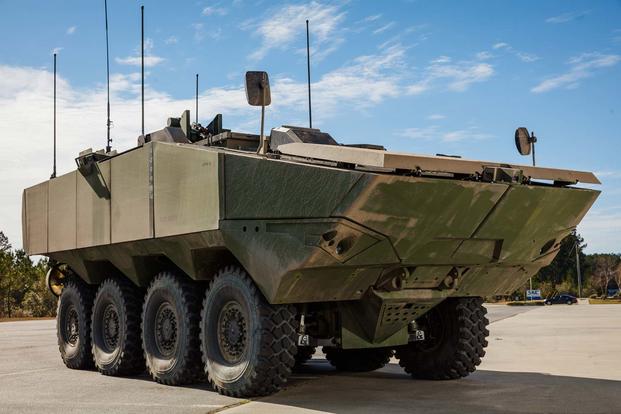After years of investing heavily in the V-22 Osprey and the F-35B Joint Strike Fighter, the Marine Corps is ready to put down some real spending money to modernize its ground vehicles.
According to President Donald Trump's fiscal 2018 budget request released Tuesday, the Marine Corps will see a bump in its base budget, $26.3 billion, up from $23.5 billion in the current year.
Operations and maintenance accounts will see a year-over-year increase of more than $1.2 billion, while personnel and procurement will see boosts of more than $500 and $700 million, respectively. And much of that procurement will be spend on combat vehicles.
The Corps is moving ahead with its plan to buy the first 26 of the Amphibious Combat Vehicle 1.1, investing $340 million in the program, including research and development and procurement. The service now has two contractors competing to build the vehicle: BAE Systems Plc and SAIC, both of which have eight-wheeled vehicles on offer.
As planned, the Corps will purchase 13 vehicles from each company as testing continues through this year. The service will down-select to one vehicle maker in 2018, with plans to build 204 of the vehicles to replace its aging amphibious assault vehicle fleet.
Meanwhile, the Marine Corps' investment in the Joint Light Tactical Vehicle Program will get a significant boost: $234 million compared to last year's $113 million. The JLTV, which is primarily being procured by the Army, is set to reach initial operational capability for that service in 2019.
"The FY 2018 request reflects increased production of JLTV, associated kits, and delivery to receiving units in support of IOC," the request's authors write.
Marine Corps Commandant Gen. Robert Neller acknowledged that he had cut investment in the JLTV in last year's budget request to protect development of the ACV and the Ground/Air Task Oriented Radar, which began fielding this year. But National Defense Magazine reported this month that the Marine Corps may now purchase more JLTVs than the 5,500 it initially planned to buy. Neller is also urging the Corps to get the vehicles to the fleet as quickly as possible, the magazine reported.
The 2018 budget request calls for purchase of 527 of the vehicles, compared with just 192 last year.
The focus on vehicles continues with the Marine Corps' operations and maintenance request. The request includes $5.57 billion in operations and maintenance funds as the service continues to work to restore its equipment after the wars in Iraq and Afghanistan. Maintenance for combat vehicles gets perhaps the most significant boost, with $135 million requested as opposed to last year's $103 million enacted. In all, ground equipment and maintenance will total $288 million in next year's budget request, compared with $207 million last year.
In personnel, the request reflects the 3,000-Marine end strength increase to 185,000 authorized by Congress last year. Neller and other Marine Corps brass have said they plan to build out specialized fields including cyber and information warfare with that increase.
"At 185,000 Marines, the Marine Corps will improve the capability and capacity in fields such as information warfare, to allow commanders the ability to fight in all five operational domains ... while maintaining effective command and control," the request's authors write.
The Marine Corps will continue to invest steadily in its aviation programs, buying another four CH-53K King Stallion aircraft as low-rate initial production is set to begin in 2018. The aircraft achieved Milestone C in April, paving the way for LRIP funding. The first operational aircraft are set to be delivered to the Marine Corps in 2020.
The Marine Corps will also buy 24 F-35B Joint Strike Fighters, continuing its investment in the program as more squadrons become active. The first active F-35B squadron moved forward to Japan in January ahead of deployment aboard a Marine expeditionary unit this fall.
The Marine Corps also plans to invest in a $16 million vertical lift fan test facility at Marine Corps Air Station Cherry Point, North Carolina, according to the request.
-- Hope Hodge Seck can be reached at hope.seck@military.com. Follow her on Twitter at @HopeSeck.




























